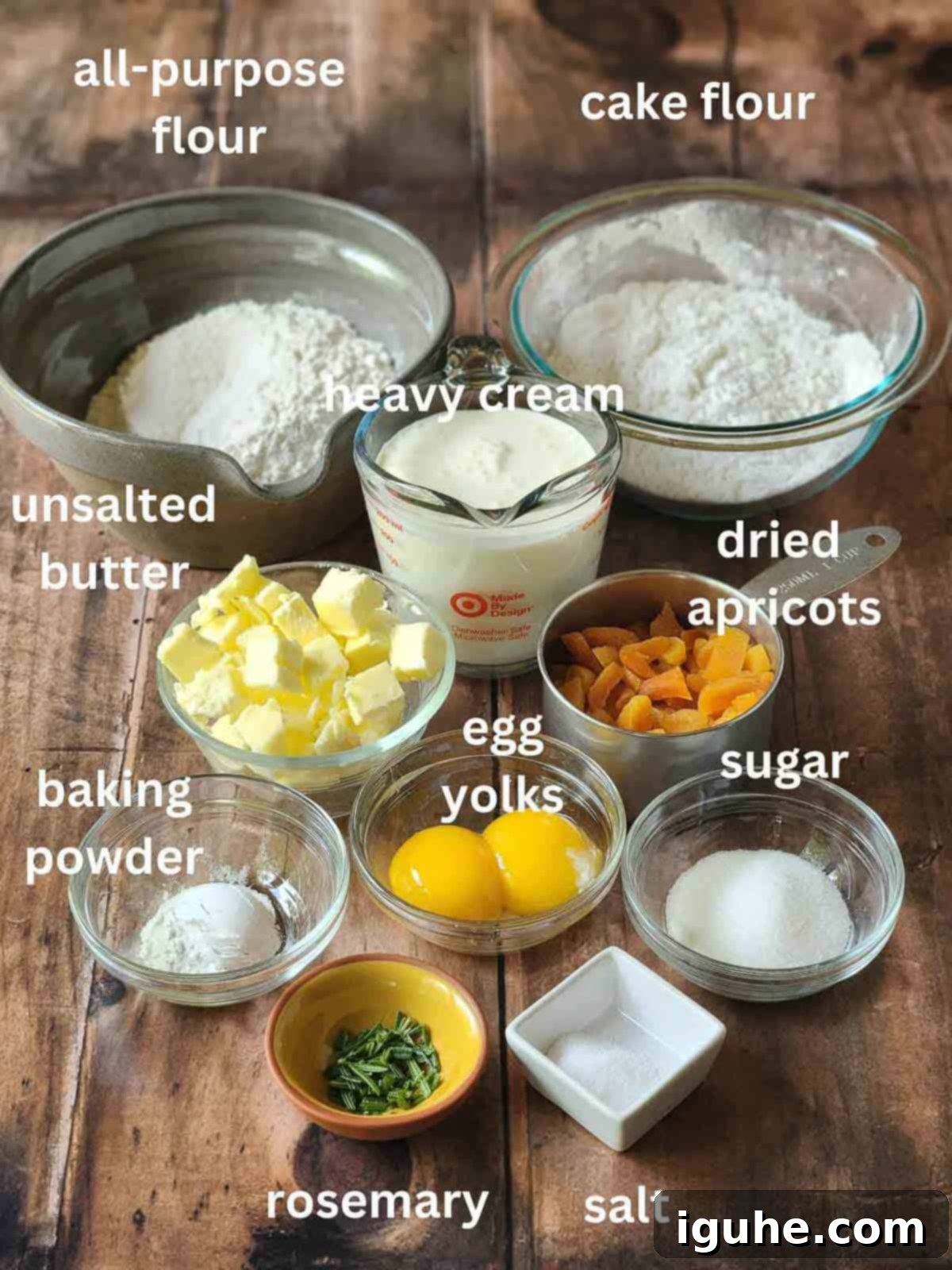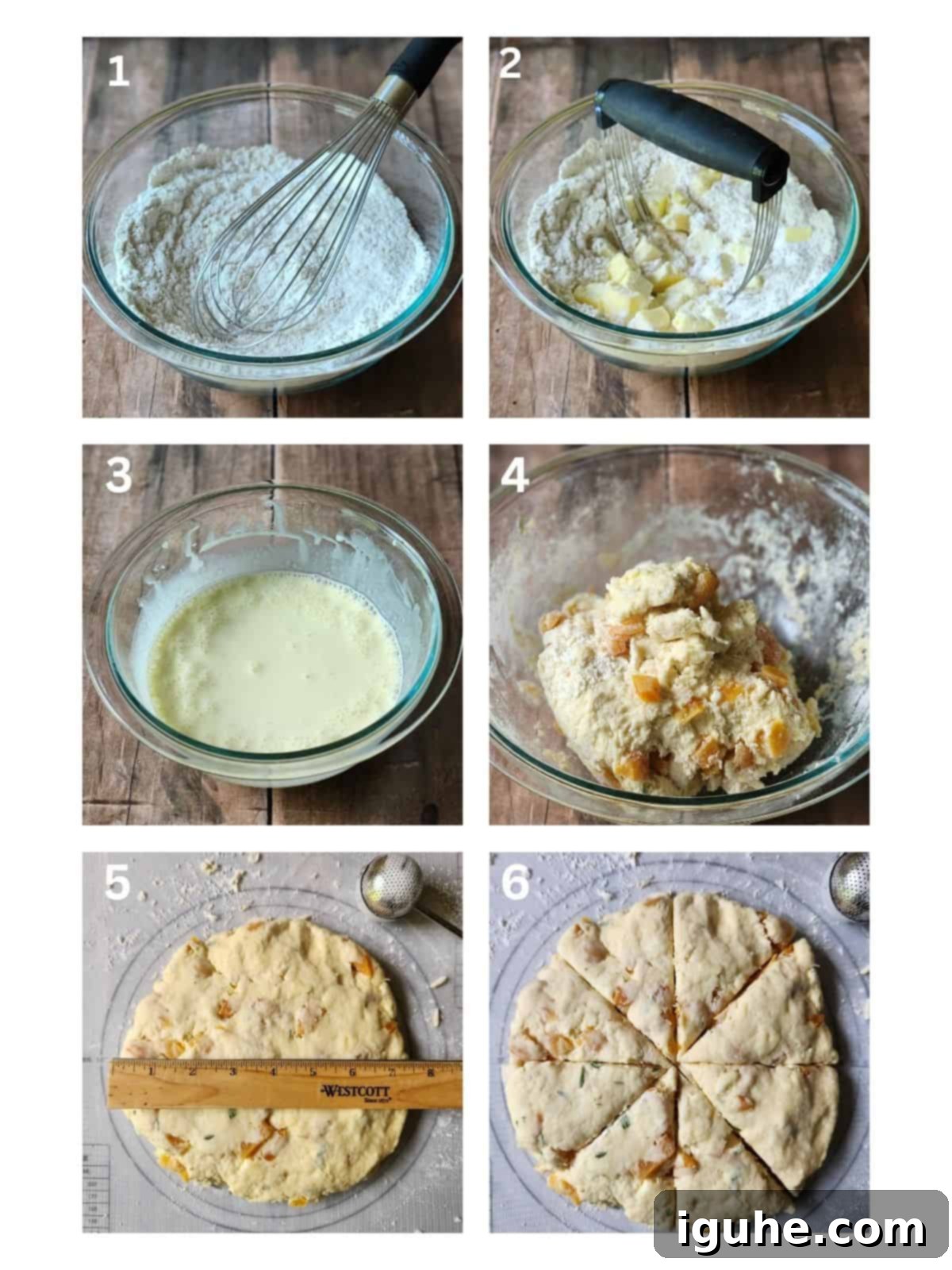Flaky Apricot and Rosemary Scones: Your Ultimate Sweet-Savory Brunch Delight
Elevate your brunch experience with these exquisitely crafted Apricot and Rosemary Scones, a recipe poised to become your go-to for special occasions and everyday indulgence. Imagine tender, flaky scones bursting with the sweet chewiness of dried apricots, perfectly complemented by the subtle, aromatic earthiness of fresh rosemary. This unique sweet-and-savory combination creates an unforgettable flavor profile that’s ideal for leisurely weekend breakfasts, elegant tea parties, or any moment that calls for a touch of culinary sunshine.

For those who have yet to explore the delightful synergy of fruit and fresh herbs in baking, these apricot rosemary scones offer a truly captivating introduction. While fresh apricots boast a fleeting season, using dried apricots provides a convenient and equally flavorful alternative, ensuring you can enjoy these delectable treats year-round. They retain all the vibrant, tangy-sweet essence of apricots, making them a pantry staple powerhouse.
What truly sets this recipe apart and makes the minimal effort incredibly rewarding? Beyond their stunning taste, these scones are remarkably easy to prepare. They can be made ahead of time, are wonderfully freezer-friendly for future enjoyment, and offer endless possibilities for customization. Serve them warm from the oven, perhaps with a generous smear of rich butter, a luxurious dollop of clotted cream, or a delicate drizzle of golden honey for an extra layer of sweetness. The enticing aroma of freshly baked scones filling your kitchen is, by itself, enough to entice anyone out of bed on a lazy morning. These aren’t just pastries; they’re an experience, promising comfort, flavor, and a touch of gourmet elegance with every bite.
Essential Ingredients for Perfect Scones
Crafting the perfect scone hinges on selecting high-quality ingredients and understanding their individual roles. Many traditional scone recipes often call for buttermilk, which contributes to a tangy flavor and tender texture. However, for these apricot rosemary scones, I prefer to use rich heavy cream. This choice results in a scone that is exceptionally moist, has a more luxurious crumb, and boasts a richer, more indulgent flavor that beautifully complements the fruit and herb combination. The cold temperature of the cream is also crucial for achieving that desirable flaky texture, as it prevents the butter from melting too quickly during mixing.

- Flour: This recipe utilizes a blend of two types of flour for optimal texture. All-purpose (AP) flour provides essential structure and a satisfying bite, while cake flour, known for its fine texture and lower protein content, contributes to a more delicate, tender crumb. This combination ensures the scones are both sturdy enough to hold their shape and delightfully soft.
- Sugar: A modest amount of white granulated sugar is incorporated to lend a subtle sweetness that balances the tartness of the apricots and the savory notes of the rosemary, enhancing the overall flavor without being overly sweet.
- Baking Powder: As the primary leavening agent, baking powder is responsible for creating those coveted light and airy scones with a beautiful, high rise during baking. Ensure your baking powder is fresh for the best results.
- Butter: The secret to truly flaky scones (and biscuits!) lies in using very cold, unsalted butter, diced into small cubes. When cold butter bits melt in the hot oven, they release steam, creating pockets of air that result in distinct, flaky layers. Using unsalted butter allows you to control the overall salt content of the recipe.
- Egg Yolks: Incorporating egg yolks into the dough provides additional richness and moisture, contributing to a more tender texture and helping the scones achieve a better rise and a golden hue.
- Heavy Cream: As mentioned, heavy cream is preferred over buttermilk for its ability to create a richer, more tender scone. Its high-fat content also aids in moisture retention and contributes to a luxurious mouthfeel. Ensure it is very cold.
- Apricots: Dried apricots are an excellent choice here. They are readily available year-round, packed with concentrated sweet and tangy flavor, and offer a pleasant chewy texture that holds up well in baking. Soaking them briefly can make them even plumper.
- Rosemary: Fresh rosemary is absolutely essential for imparting its distinct, earthy, and slightly piney aroma and flavor. While dried rosemary can be used in a pinch, fresh sprigs will yield a far superior and more fragrant scone. Chop it finely to ensure even distribution.
- Salt: A touch of Kosher or fine sea salt is crucial for enhancing all the other flavors, balancing the sweetness, and bringing out the depth of both the apricots and the rosemary.
A comprehensive ingredient list, with precise measurements, is readily available in the detailed recipe card at the bottom of this article.
Simple Step-by-Step Baking Guide
Follow these easy steps to create delicious, flaky savory-sweet scones infused with apricot and rosemary. The following visuals provide an abbreviated overview of the process. For a complete, detailed list of instructions, please refer to the recipe card provided below.

Step 1. Prepare Dry Ingredients: In a large bowl, whisk together the flours, sugar, baking powder, and salt. Step 2. Incorporate Butter: Add the very cold, cubed butter to the dry mixture and cut it in using a pastry blender or two forks until the butter pieces are about the size of small peas. Step 3. Mix Wet Ingredients: In a separate bowl, whisk together the cold egg yolks and heavy cream. Step 4. Combine and Fold: Pour the wet mixture into the dry ingredients, stirring just until a rough, shaggy dough begins to form. Gently fold in the chopped dried apricots and fresh rosemary until they are evenly distributed throughout the dough. Avoid overmixing to keep the scones tender. Step 5. Shape the Dough: Lightly flour a clean surface and turn out the dough. Gently pat or roll it into a round disc, approximately 7 inches in diameter and 1 inch thick. Step 6. Cut into Wedges: Using a sharp knife or a bench scraper, carefully slice the round dough into 8 equal wedges.

Final Baking Steps: Arrange the cut scone wedges onto a prepared baking sheet, leaving a small space between each. Transfer the baking sheet to the refrigerator and chill for a crucial 15 minutes. This chilling period helps the butter solidify, promoting flakier layers. Once chilled, remove the baking sheet, brush the tops of each scone with a simple egg wash (a whisked egg with a splash of cream or milk), and lightly sprinkle with a pinch of flaky sea salt. Bake the scones in a preheated 400°F (200°C) oven for 18-22 minutes, or until their tops are beautifully golden brown and the scones are puffed. Allow them to cool slightly on a wire rack before serving to fully set.
👩🍳 Expert Tips for Scone Perfection
Achieving truly exceptional scones is an art form, but with these expert tips, you’ll be baking like a pro in no time. Each step is designed to maximize flavor, texture, and rise, ensuring your apricot and rosemary scones are consistently outstanding.
- Keep Your Ingredients Ice Cold: This is arguably the most critical rule for flaky scones. Cold butter, heavy cream, and even egg yolks are essential. When tiny pieces of cold butter hit the hot oven, they release steam, creating those signature airy pockets and distinct flaky layers. If your kitchen is warm, you might even consider chilling your flour and mixing bowl for a few minutes before starting.
- Prioritize Fresh Rosemary: While dried rosemary can be a last resort, fresh rosemary offers an incomparably vibrant, fragrant, and earthy flavor that truly elevates these scones. The essential oils in fresh herbs are much more potent and aromatic. If using dried, remember to significantly reduce the quantity (to about ½ teaspoon) as its flavor is more concentrated. For other delicious uses of fresh rosemary, check out this rosemary and fig candied bacon recipe.
- Avoid Overmixing the Dough: Scone dough should be handled gently and minimally. Overmixing develops the gluten in the flour, leading to tough, dense scones instead of light and tender ones. Stop mixing as soon as the ingredients are just combined and a shaggy dough forms. It’s perfectly fine if there are still some dry bits; these will incorporate during the gentle shaping.
- Chill the Dough Before Baking: This step is not optional for best results. A brief rest in the refrigerator (15-20 minutes) after cutting helps solidify the butter again, which may have softened slightly during mixing and shaping. This ensures the butter melts slowly and releases steam effectively, resulting in a superior rise and flakier texture.
- Don’t Twist Your Cutter (if using): If you opt for round scones and use a biscuit cutter, press straight down without twisting. Twisting seals the edges of the scone, inhibiting its ability to rise fully and create those beautiful flaky layers.
- Use a Hot Oven: Scones need a high temperature to achieve a rapid rise. A hot oven helps to quickly set the exterior of the scone while allowing the interior to bake through and the butter to create steam, contributing to that desired airy texture. Make sure your oven is fully preheated before placing the scones inside.
Delightful Variations to Explore
While the classic apricot and rosemary combination is truly outstanding, these scones are incredibly adaptable. Feel free to experiment with these simple swaps and additions to tailor them to your taste and elevate your apricot scones to the next level of culinary creativity!
- Thyme for a Milder Herbaceous Note: If you prefer a softer, slightly more delicate herbaceous flavor, swap the rosemary for fresh thyme. Thyme offers a subtle lemony, peppery note that pairs beautifully with apricots and offers a different aromatic dimension.
- Brighten with Lemon Zest: For an invigorating citrus kick, add 1-2 teaspoons of finely grated lemon zest to the dry ingredients. The bright, zesty aroma of lemon enhances the sweetness of the apricots and provides a wonderful counterpoint to the rosemary (or thyme).
- Floral Elegance with Lavender: For an unexpected yet exquisite floral touch, introduce a tiny pinch of culinary lavender into the dough along with the apricots. Be sparing, as lavender can be potent, but a small amount creates a sophisticated, tea-time scone vibe that is truly special.
- Savory Cheese Infusion: To balance the sweetness with a delightful savory element, consider folding in some crumbled goat cheese for a tangy creaminess, or a bit of finely grated sharp cheddar cheese for a more robust, salty flavor. These additions transform the scone into a more versatile treat, perfect for cheese boards or savory brunches.
- Nutty Crunch: Add about ¼ to ½ cup of finely chopped nuts like pecans, walnuts, or almonds for an extra layer of texture and a rich, nutty flavor. Toasting the nuts lightly beforehand will enhance their aroma.
- Spice It Up: A pinch of warm spices like cardamom, ginger, or cinnamon can add depth and complexity to the apricot flavor, especially during cooler months.
- Glazed Perfection: For an extra touch of sweetness and visual appeal, consider drizzling a simple lemon or orange glaze over the cooled scones. Whisk powdered sugar with a small amount of citrus juice until a smooth, pourable consistency is achieved.

Creative Serving Suggestions
These apricot and rosemary scones are absolutely divine on their own, especially when fresh from the oven with just a good old-fashioned slather of butter. However, they’re incredibly versatile and can be transformed into an array of delightful dishes to make them the star of any gathering. Here are a few more ideas to inspire your culinary creativity!
- The Classic Tea or Coffee Companion: There’s nothing quite like a warm scone paired with your favorite hot beverage. Host an elegant tea party and serve these alongside a selection of fine teas. Floral teas, such as a delicate lavender latte, complement the apricot and rosemary beautifully, creating a harmonious flavor experience. For coffee lovers, a robust dark roast provides a comforting contrast.
- Inspired Scone Shortcakes: Give a rustic dessert a sophisticated twist by transforming these scones into delightful shortcakes. Simply slice a scone in half horizontally, generously layer with freshly whipped cream, and spoon on some homemade apricot preserves or a vibrant berry compote (like these cranberry shortcakes). This creates an easy yet impressive dessert that highlights the scone’s tender crumb and aromatic flavors.
- A Star on Your Brunch Board: For an impressive and interactive presentation, cut the scones into mini triangles before baking, or slice baked scones into smaller portions. Arrange them as a centerpiece on a lavish brunch board or a themed butter board. Surround them with an assortment of fresh seasonal fruits, a selection of artisanal cheeses (goat cheese or brie would be fantastic), and various sweet spreads like fruit jams, honey, or even a citrus curd. This allows guests to create their own perfect bite.
- Savory Sandwich Base: For a more savory approach, split a scone and fill it with thin slices of prosciutto, a dollop of cream cheese, and a sprinkle of fresh arugula. The sweet apricot and herbaceous rosemary provide a unique background for these savory components.
- Alongside Soups or Salads: Serve warm mini scones as an unexpected side with a light lunch. They pair wonderfully with a creamy tomato soup or a fresh green salad with a vinaigrette dressing, offering a delightful textural and flavor contrast.
Storage and Make-Ahead Options
While these apricot and rosemary scones are truly at their peak when served fresh from the oven, their deliciousness doesn’t have to be fleeting. With proper storage, you can extend their enjoyment, and with make-ahead options, you can savor freshly baked scones with minimal effort on demand.
Storing Baked Scones: For optimal freshness, these scones are best enjoyed on the day they are baked. However, if you have any leftovers, they will keep well for about 1-2 days at room temperature. To prevent them from drying out, ensure they are stored in an airtight container or individually wrapped tightly in aluminum foil or plastic wrap. To refresh day-old scones, a quick re-warm in a preheated oven (around 300°F/150°C for 5-7 minutes) can bring back some of their original warmth and tenderness.
Freezing Unbaked Scone Dough: This is a fantastic make-ahead option that allows you to enjoy freshly baked scones whenever the craving strikes. After you have cut the scone dough into triangles, place the unbaked wedges on a baking sheet lined with parchment paper and freeze them until solid (about 30-60 minutes). Once firm, wrap each scone tightly in plastic wrap and then store them in a freezer-safe bag or airtight container for up to 3 months. When you’re ready to bake, there’s no need to thaw them! Simply place the frozen scones on a prepared baking sheet, brush with egg wash, sprinkle with salt, and bake from frozen. You will need to add a little extra baking time, typically an additional 5-10 minutes, or until golden brown and cooked through.
Freezing Baked Scones: You can also freeze baked scones. Allow them to cool completely, then wrap each scone individually in plastic wrap and then in foil, or place them in a freezer-safe container. They can be frozen for up to 1 month. To reheat, thaw them at room temperature for a few hours, then warm them in a moderate oven (325°F/160°C) for about 10-15 minutes until heated through.

Frequently Asked Questions (FAQ)
Here are answers to some common questions about making and enjoying these delightful apricot and rosemary scones:
Yes, absolutely! While dried apricots are convenient, fresh apricots can also be used when in season. If using fresh, make sure they are firm and not overly ripe to prevent them from releasing too much moisture into the dough, which can affect the scone’s texture. Dice them into small pieces and gently pat them dry with a paper towel before folding them into the dough. This extra step helps manage moisture levels and ensures a tender scone.
You don’t *have* to, as many recipes call for them to be added directly. However, soaking dried apricots in warm water for 5-10 minutes can make them noticeably plumper and juicier in the final scone, enhancing their texture and taste. If you choose to soak them, it’s crucial to drain them exceptionally well and gently pat them thoroughly dry with a kitchen towel or paper towels. Excess moisture is the enemy of flaky scones and can lead to a crumbly or dense texture.
While fresh rosemary is highly recommended for its vibrant and earthy flavor profile, dried rosemary can be used as a substitute if fresh is unavailable. Due to its concentrated flavor, you should reduce the amount. Use about ½ teaspoon of dried rosemary for every 2 teaspoons of fresh. Keep in mind that the flavor will be less intense and a bit different from using fresh.
Several factors can affect scone rise. The most common culprits are old baking powder (always check its freshness!), overmixing the dough (which develops gluten and makes scones tough), or warm butter (which melts too quickly and prevents steam pockets). Ensuring your ingredients are cold, handling the dough minimally, and using fresh baking powder are key to a good rise.
Yes, you can use a food processor to quickly cut the butter into the flour mixture. Pulse the cold butter with the dry ingredients until coarse crumbs form. Be careful not to overmix, as the food processor can quickly develop gluten and warm the butter. Once the butter is incorporated, transfer to a bowl and gently mix in the wet ingredients and add-ins by hand.
More Savory-Sweet Recipes to Love
Whether your preference leans towards savory, sweet, or that delightful combination of both, these favorite recipes are perfect for making on repeat. Expand your culinary repertoire with these delicious and inspiring ideas!
- Refreshing Lavender Lemonade
- Roasted Balsamic Fig Toast
- Vanilla Cranberry Compote
- Bourbon Bacon Chutney
Did you make this delightful recipe? I would be thrilled to hear about your experience! Please consider leaving a ⭐⭐⭐⭐⭐ rating and a comment directly below the recipe card. If you capture a photo of your culinary masterpiece, remember to tag me on Instagram @brunchandbatter. Your feedback and shares truly brighten my day!
📖Recipe

Apricot and Rosemary Scones
Equipment
- pastry blender/cutter optional
- baking sheet
- parchment paper or silicone baking mat
Ingredients
- 1 cup all-purpose flour
- 1 cup plus 2 tbsp cake flour (also called super-fine or extra-fine flour)
- 1 tablespoon baking powder
- 2 tablespoon white granulated sugar
- ¾ teaspoon Kosher or fine sea salt
- 6 tablespoon cold, unsalted butter, diced into cubes
- 2 large egg yolks, cold
- 1 cup heavy cream (whipping cream), cold
- 2 teaspoon chopped fresh rosemary
- ¾ cup chopped dried apricots
Egg wash and topping
- 1 large egg
- 1 teaspoon heavy cream or milk
- ⅛-¼ teaspoon Kosher or flaky sea salt
Instructions
- Preheat the oven to 400°F. Line a baking sheet with parchment paper or a silicone baking mat.
- Soften the apricots: Place the dried apricots in a bowl and cover with warm water. Let soak for 10 minutes until plump. Drain well, then gently pat dry with a kitchen towel or paper towels to remove excess moisture. Too much water can cause the scones to fall apart.
- In a large bowl, sift together the flours, sugar, baking powder, and salt.1 cup all-purpose flour, 1 cup plus 2 tablespoon cake flour, 1 tablespoon baking powder, 2 tablespoon white granulated sugar, ¾ teaspoon Kosher or fine sea salt
- Add the cold, cubed butter and cut it into the dry ingredients using a pastry blender or two forks until the mixture resembles coarse crumbs with pea-sized bits of butter. Gently fold in the apricots and rosemary until evenly distributed.6 tablespoon cold, unsalted butter, diced into cubes, 2 teaspoon chopped fresh rosemary, ¾ cup chopped dried apricots
- In a separate bowl, whisk together the egg yolks and heavy cream. Pour the mixture into the flour mixture and stir just until a shaggy dough forms. Using your hands, gently knead the dough in the bowl a few times to incorporate any remaining dry bits-be careful not to overwork it. The dough should be slightly wet and crumbly but hold together. Turn it out onto a lightly floured surface and shape it into a round, about 7 inches in diameter and 1 inch thick.2 large egg yolks, cold, 1 cup heavy cream (whipping cream), cold
- Using a sharp knife or bench scraper, cut the dough round into 8 equal wedges. Place the scones on the prepared baking sheet, spacing them slightly apart. Transfer the baking sheet to the refrigerator and chill for 15 minutes before baking.
- After chilling, remove the scones from the refrigerator (chilling helps solidify the butter, which leads to flakier layers and better rise in the oven). In a small bowl, whisk together the egg and heavy cream to make an egg wash. Brush the tops of each scone with the egg wash, then sprinkle with a pinch of salt. Bake at 400°F for 18-22 minutes, or until golden brown. Let cool on a wire rack for about 15 minutes before serving.1 large egg, 1 teaspoon heavy cream or milk, ⅛-¼ teaspoon Kosher or flaky sea salt
Notes
- Keep your ingredients cold. Cold butter is key to creating those signature flaky layers- so chill everything, including your cheese and cream, before starting.
- Use fresh rosemary for the best flavor. Dried rosemary is great in a pinch, but fresh rosemary is much more fragrant and earthy.
- Don’t overmix the dough. Stop mixing when the dough is just combined- it should look slightly wet and shaggy. It will come together as you shape it.
- Chill the dough before baking. A short rest in the fridge helps keep the butter cold, resulting in flakier scones with a better rise in the oven.
- Storage. These scones are best served the day they are made, but can be stored up to 2 days after baking. To maximize freshness, store in an airtight container at room temperature.
- To freeze scones. Freeze them right after you cut them into triangles. Wrap each one tightly, then store in a freezer-safe bag for up to 3 months. When ready to bake, you can pop them in the oven from frozen and just add a little more baking time.
Nutrition*
*Nutrition information is provided as a courtesy and is an estimate only. Nutrition information can vary depending on many factors, such as products used, measurements and substitutions, therefore it is recommended that you obtain nutritional calculations based on your own finished recipe.
